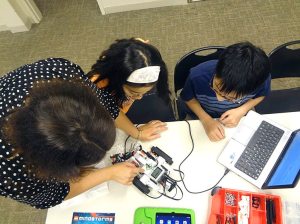
Like something out of a sci-fi movie, the robots are taking over the Syosset Public Library this summer.
Mindstorms are the latest in the evolution of the enduringly popular Lego brand of building blocks. The complex kits give users the ability to not only build an actual Lego robot, but also to program it to move and interact with its environment. Teen services librarian Sharon Long introduced this exciting concept to local kids at the library during July.
“It’s basically taking the building aspects of Legos and adding a whole robotics and programming element to it,” she said. “You’re not just building something and letting it stand there, you’re actually able to use programming language to move it about and command it to do things and we wanted to introduce it here in a low-pressure environment. It’s been great…everybody’s working on their own project and I try and answer questions and guide them with software.”

The physical Mindstorm kits offer pre-set configurations or the freedom to experiment to see what works, all the way from small robots who roll about on tank-like treads to semi-humanoid models. But the more you shy away from the instructions when building your robot—just as when you’re programming it—the better chance less advanced users have of putting together something that doesn’t quite work right. However, Long said that there’s quite a bit of variety that comes with Mindstorm and with that comes a great deal of leeway in how you can approach it.
“There are five different robots that you can build in the standard kits that we have and they’re all pretty straightforward. There’s instructions on how to make each one,” she said. “Beyond that, they give you options to modify them. You can have them shoot balls at targets or install hands to grip things. So, you’re not limited, you can indulge your imagination.”
A lot of options are given when it comes to actually programming the robot. Users can lay out a series of pre-set instructions for the mechanical pal to play out or more advanced users can create a dynamic series of commands from traveling from set points to picking up and dropping items and much, Long said.

“The nice thing about these kits is that they give you lots of different platforms to practice programming with,” she said. “You can use the software that they come with on a laptop, but we also have apps that you can use on an iPad. They give you a 3D building app—they’re like the typical Lego step-by-steps, but you can actually rotate the model around and get a better view of where the pieces are—as well as a 3D command app, which lets you use the iPad as a big remote control to command these little robots around the room.”
Despite the configuration the user may choose, all Lego Mindstorm robots share three basic elements that, when combined, allow them to actually move and do things. First is the “brick,” which is a square device that receives and runs any programs inputted into it. Attached to the brick are motors, which move the parts you attach to the robot, and sensors, which enable the robot to detect aspects of its surroundings. When correctly combined with other Lego parts and items that come with the Mindstorm kit, an industrious guy or gal can create a pretty smart little mechanical doo-dad, Long said.
“They have color sensors, for example. So, you can program them to turn or throw something when they reach a colored marker. They can also respond to touch or light commands. If the lights go out in the room, you can program them to react to it,” she said. “Everything is just based on using sensors and motors, so it’s really interesting. But if you’re just starting out and you just want a little robot to follow you around the house, you can also just use the remote control to have fun with it as well.”
Dil, 12, is a newcomer to the world of Lego Mindstorms, but after his experience during this summer workshop at the Syosset Library, he said he will be first in line when the next program is offered.
“I like Legos and I like programming stuff, so this brings them both together,” he said. “I’ve been to every class here and I’ve managed to make a robot that can move and pick up things. It’s been a lot of fun.”
Nolan, also 12, said that he had some experience with robotics from classes at school and said that Lego Mindstorms comparatively offered just as many possibilities for exciting experimentation.
“It’s cool to program stuff to make it move on its own while you’re watching,” he said. “So far, we’re made our robot knock over things and shoot rubber balls at targets. If they hold more classes I’ll definitely come.”
This is the first Lego Mindstorms program at the Syosset Library—it started June 30 and lasted for three weeks—but based on the response there are already plans to expand it into the fall and beyond. Making this type of programming available to children at the library, Long noted, is important in this day and age where programing and engineering are becoming far more commonplace in the working world.
“My hope is to reach out to the Mindstorm clubs at the local schools and let them know that we have the kits as well. This way, if they need additional practice they can come,” she said. “With all of the push for science, technology and math, this is a good way to focus on learning a little more about that. Besides, I don’t know how much time they get to actually play around in school anymore, and there’s something to be said for learning while playing.”



























